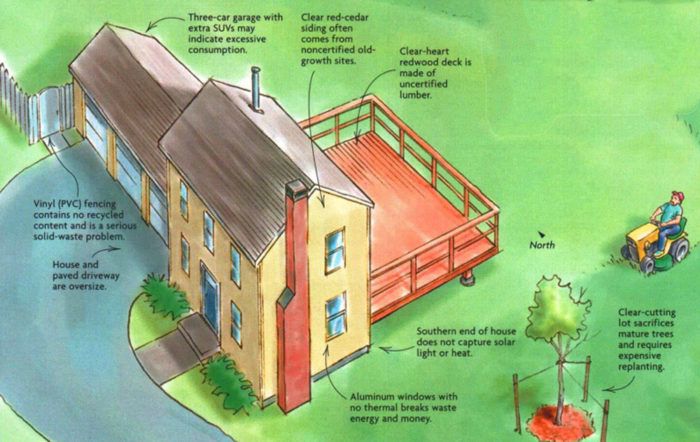Inexpensive Strategies for Green Building
Yes, recycled lumber and plantation-grown lumber cost more, but designing smaller houses, orienting them for solar gain and minimizing job-site waste don't.

Synopsis: “Green” buildings are in vogue, but what does the term really mean? The Vermont-based editor of the widely respected Environmental Building News answers that question in this article and proposes a number of steps builders can take to conserve building materials and energy while doing more to protect the environment.
Many designers and builders think of green building as just another add-on option for potential home buyers to consider: “So do you want the master-bath bump-out with spa ($4,800), the three-car garage ($10,500) and our exclusive ‘green’ package (just $3,500)?”
Owners then mix and match these options, trading off conflicting priorities, to stay within their budget. “We’ll go with the master-bath option, but stick with the two-car garage; and how much of that green package can you provide for $2,500?”
While quite common today, this à la carte approach largely misses the point of green building. Limiting green building to a collection of add-ons almost guarantees that the finished product will fail to be as green as possible, no matter what the budget.
I suggest a different approach. Instead of beginning with a collection of high-profile (and often expensive) green features to add to a house, let’s integrate from the start ten basic strategies that dramatically increase sustainability but add little or no cost. Some even reduce costs. Even strategies that do increase purchase price slightly may reduce the total cost of ownership (due to the lower utility bills or reduced maintenance costs) while providing a greener product.
Green homes are often fairly expensive, but they don’t need to be. You can usually implement the following strategies with little or no net increase in the house’s overall price. You can certainly go a lot farther, installing solar panels on the roof, recycled-glass tiles in the bathrooms and certified-wood cabinets in the kitchen and I hope you will consider these options but you don’t have to spend any more to build a green home.
Make houses no larger than necessary
Since 1950, the average U. S. house size has more than doubled while the average family size has dropped 25%. Put another way, the average house in 1950 provided 290 sq. ft. per family member; the average house today provides more than 800 sq. ft., a 2.8-fold increase. Scaling back not only reduces the environmental impacts of building and operating that house, but it also saves money.
Depending on how much we reduce overall house size, we may save money even while spending more per square foot on better quality finishes, extra amenities and perhaps even some of those more-expensive green features. Building smaller isn’t easy, though. It takes a good designer to create a small house that functions well and doesn’t feel cramped. Sarah Susanka’s book, The Not So Big House (The Taunton Press, 1998), provides a superb, beautifully illustrated overview of creating smaller houses that work.
For more photos and strategies for building green, click the View PDF button below.
Fine Homebuilding Recommended Products
Fine Homebuilding receives a commission for items purchased through links on this site, including Amazon Associates and other affiliate advertising programs.

A Field Guide to American Houses

Code Check 10th Edition: An Illustrated Guide to Building a Safe House

Musings of an Energy Nerd: Toward an Energy-Efficient Home

























